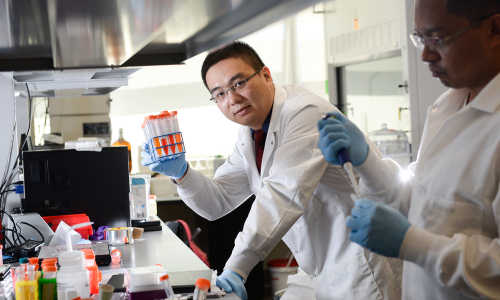Researchers have developed a potential new weapon in the fight against cancer: a daisy-shaped drug carrier that’s many thousands of times smaller than the period at the end of this sentence.
Once injected into the bloodstream, millions of these “nanodaisies” sneak inside cancer cells and release a cocktail of drugs to destroy them from within. The approach is more precise than conventional methods, and it may also prove more effective. By ensuring anti-cancer drugs reach their target in controlled, coordinated doses, nanodaisies could cut down on the side effects of traditional chemotherapy.
“By using one nanocarrier to contain two different drugs, we can potentially reduce their dose and toxicity,” said Dr. Zhen Gu, assistant professor in the Joint Department of Biomedical Engineering at NC State and UNC-Chapel Hill. “And meanwhile their anti-cancer efficacy is enhanced.”
The nanocarriers are made from a polymer called polyethylene glycol (PEG), to which researchers attach the cancer-killing drug camptothecin (CPT) like bunches of grapes on a vine. A second drug, doxorubicin, also floats in solution around the PEG.
Both drugs are hydrophobic, meaning they dislike water and shy away from it. PEG, though, is hydrophilic: When exposed to water it stretches out to maximize contact, while the T-shaped joints that hold the CPT tug in the opposite direction and fold inward. The anti-cancer drugs thus end up tucked into a protective shell of PEG. The resulting nanocarrier is shaped like a flower — hence the term “nanodaisy.”
“The idea came from thinking actively about folding proteins in nature,” noted Gu, referring to the way amino acids can assemble themselves into thousands of different shapes. “It’s a sort of bio-inspired design.”
Once folded, the nanodaisies are then injected into the bloodstream and absorbed by unwitting cancer cells, which are porous enough to let them in. The nanodaisies’ outer shells of PEG protect their payload of drugs and keep them from prematurely leaking.
The design of the nanodaisy also ensures that the two cancer drugs release at complementary speeds as their carrier comes apart inside the cancer cell. Each drug inhibits different enzymes in the cell, and they work in tandem to prevent or delay the development of drug resistance.
The result is that the drugs launch an attack on cancer that’s more closely coordinated and tightly targeted than traditional drug cocktails.
So far, in vivo testing in mice has shown that this approach produces significant accumulation of drugs in tumor sites instead of healthy organs. Gu noted that in vitro testing had also demonstrated the potential of nanodaisies to effectively target different kinds of cancer.
“It’s shown a broad killing effect for a variety of cancer cell lines, including leukemia, breast and lung cancers,” he said.
Gu has led other research that has yielded a bio-inspired “cocoon” that tricks cells into consuming anti-cancer drugs and an injectable nano-network that controls blood sugar levels in diabetics. He is supported by faculty, staff and Ph.D. students in the Joint Department of Biomedical Engineering, a partnership between NC State and UNC-Chapel Hill that tackles urgent biomedical problems.
The next step for nanodaisies is preclinical testing to determine whether they might be ready to fight cancer in humans.
For Gu, that prospect has personal significance: His father was diagnosed with cancer when Gu was still in the womb. When friends and family came to console Gu’s mother, she told them that the baby she was carrying might one day help to treat cancer.
“I don’t want to say it’s a mission, but it is a passion that drives me,” Gu explained. “Before I came to the U.S., I did research on conducting plastics for electronic devices. When I moved into the cancer treatments with nanotechnology, that’s when my mum became really excited about my work.”
Story Source:
The above story is based on materials provided by NC State University.





